Author: Arthur Hayes, co-founder of BitMEX; Translated by: Baishui, Jinse Finance
Some of you might say something like:
“The crypto bull run is over.”
“I need to launch my token now because we are in the downside of the bull run.”
“Why hasn’t Bitcoin risen in tandem with the Nasdaq 100 index of large U.S. technology companies?”
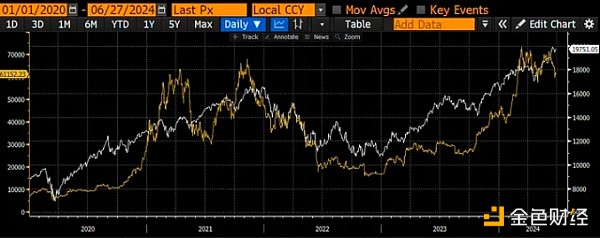
This chart of the Nasdaq 100 (white) versus Bitcoin (gold) shows that both assets move in tandem, but Bitcoin has been stagnant since hitting an all-time high earlier this year.
But then the same group of people made the following point:
“The world is moving from a unipolar world order dominated by the United States to a multipolar world order that includes leaders such as China, Brazil, Russia, etc.”
“In order to finance government deficits, savers must be financially repressed and central banks must print more money.”
"World War III has already begun, and war will cause inflation."
Some of the views on the current phase of the Bitcoin bull run and their views on the geopolitical and global monetary situation confirm my view that we are at a turning point. We are moving from one geopolitical and monetary global arrangement to another. While I don’t know the exact endpoint of the steady state, which countries will rule and what the trade and financial architecture will look like, I do know what it will look like.
I want to step away from the current vicissitudes of crypto capital markets and focus on the broader cyclical trend reversal we are in. I want to break down the three major cycles from the Great Depression of the 1930s to today. This will focus on Pax Americana because the entire global economy is a derivative of the financial policies of the ruling empire. Unlike Russia in 1917, Pax Americana did not suffer a political revolution as a result of two world wars. Most importantly for this analysis, Pax Americana is the best place to hold capital in relative terms. It has the deepest stock and bond markets and the largest consumer market. Therefore, it is important to understand and predict the next major cycle.
There are two types of periods in history: local periods and global periods. In local periods, authorities financially suppress savers to finance past and present wars. In global periods, financial deregulation promotes global trade. Local periods are inflationary periods, while global periods are deflationary periods. Any macro theorist you follow will have a similar taxonomy to describe the major cycles in history during the 20th century and beyond.
The purpose of this history lesson is to invest wisely throughout the cycles. In a typical 80-year life expectancy, you can expect to go through two major cycles, on average. I group our investment choices into three categories:
If you believe in the system but not the people who manage it, then you invest in stocks.
If you believe in the system and those who run it, then you invest in government bonds.
If you don’t trust the system or the people who run it, you can invest in gold or other assets that don’t require any trace of a state to exist, such as Bitcoin.
During periods of local inflation, I should hold gold and avoid stocks and bonds.
In times of global deflation, I should hold stocks and avoid gold and bonds.
Unless I am allowed unlimited access to them at low or no cost, or am forced by a regulator to hold them, government bonds generally do not retain their value over time. This is largely because politicians are too easily tempted to distort the government bond market by printing money through unpopular direct taxation to finance their political goals.
Before describing the cycle over the last century, I want to describe a few key dates.
April 5, 1933 – This is the day that President Franklin Delano Roosevelt signs an executive order banning private ownership of gold. He then violates the United States’ commitment under the gold standard by devaluing the dollar from $20 to $35 per gold.
December 31, 1974 – On this day, US President Gerald Ford restored the right of Americans to privately own gold.
October 1979 - Paul Volker, chairman of the Federal Reserve, changes U.S. monetary policy, shifting the target from interest rate levels to the amount of credit. He then begins starving the U.S. economy of credit to curb inflation. In the third quarter of 1981, the 10-year Treasury yield reached 15%, a record high yield and a record low bond price.
January 20, 1980 – Ronald Reagan is sworn in as President of the United States. He continues his aggressive deregulation of the financial services industry. Other notable financial regulatory reforms he subsequently made include making capital gains tax treatment of stock options more favorable and repealing the Glass-Steagall Act.
November 25, 2008 – The Federal Reserve begins printing money under its quantitative easing (QE) program. This is a response to the global financial crisis, which was triggered by losses on subprime mortgages on the balance sheets of financial institutions.
January 3, 2009 - Satoshi Nakamoto's Bitcoin blockchain releases the Genesis Block. I believe that our savior will save humanity from the evil clutches of the state by creating a digital cryptocurrency that can compete with digital fiat currencies.
1933–1980 The U.S. Dominion Upward Local Cycle
1980–2008 The global cycle of American hegemony
2008–Present American rule and China’s local cycle
1933–1980 American Upward Cycle
Relative to the rest of the world, the United States emerged from the war unscathed. Considering American casualties and property losses, World War II was less deadly and destructive than the Civil War of the 19th century. While Europe and Asia lay in ruins, American industry rebuilt the world and reaped huge rewards.
Although the United States was victorious in the war, it still needed to pay for the war through financial repression. Starting in 1933, the United States banned the holding of gold. In the late 1940s, the Federal Reserve merged with the U.S. Treasury. This allowed the government to conduct yield curve control, which resulted in the government being able to borrow at below market rates because the Fed printed money to buy bonds. To ensure that savers could not escape, bank deposit rates were capped. The government used marginal dollar savings to pay for World War II and the Cold War with the Soviet Union.
If gold and fixed-income securities that pay interest at least at the rate of inflation are banned, what can savers do to fight inflation? The stock market is the only option.
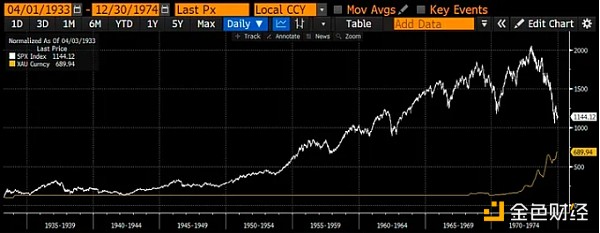
The S&P 500 (white) and Gold (gold) are indexed at 100, starting on April 1, 1933 and ending on December 30, 1974.
Even as gold prices rose after President Richard Nixon ended the gold standard in 1971, its returns have yet to beat those of stocks.
But what happens when capital is free to bet against the system and the government again?
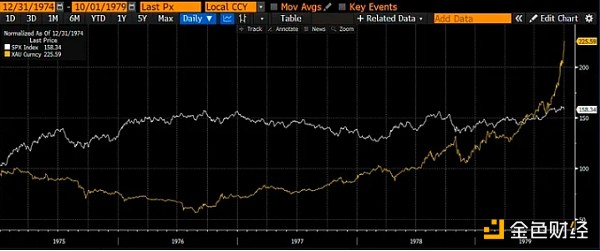
The S&P 500 (white) versus the Gold (gold) Index (100) from December 31, 1974 to October 1, 1979.
Gold outperformed stocks. I stopped the comparison in October 1979 when Volcker announced that the Fed would begin a major contraction of outstanding credit, thereby restoring confidence in the dollar.
1980–2008 Peak American Rule Global Cycle
As confidence grew that the United States could defeat the Soviet Union, the political winds shifted. It was time to move away from the war economy, to unwind the financial and other regulations of the empire, and to let those animal spirits run wild.
Under the new petrodollar monetary architecture, the dollar was supported by surplus oil sales from Middle Eastern oil producers such as Saudi Arabia. In order to maintain the purchasing power of the dollar, it was necessary to raise interest rates to curb economic activity and, in turn, inflation. That’s what Volcker did, he let interest rates soar and the economy tank.
The early 1980s marked the beginning of the next cycle, during which the United States traded with the world as the sole superpower and the dollar strengthened due to monetary conservatism. As expected, gold underperformed against stocks.
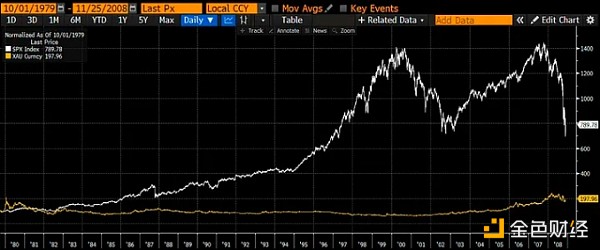
Ratio of the S&P 500 (white) to the Gold (gold) index equal to 100, from October 1, 1979 to November 25, 2008.
2008 – Pax Americana and China’s Local Cycle
Faced with yet another deflationary economic collapse, the Pax Americana once again defaulted and devalued. This time, rather than banning private gold ownership and then letting the dollar depreciate against gold, the Fed decided to print money and buy government bonds, euphemistically known as quantitative easing. In both cases, the volume of dollar-based credit expanded rapidly to “save” the economy.
Proxy wars between the major political groups began again. A major turning point was Russia's invasion of Georgia in 2008, in response to its intention to admit Georgia to the North Atlantic Treaty Organization (NATO).
Currently, a fierce proxy war is being fought between the West (Pax Americana and its proxies) and Eurasia (Russia, China, Iran) in Ukraine and the Levant (Israel, Jordan, Syria, and Lebanon). Both conflicts have the potential to escalate into nuclear confrontations on both sides. In response to the seemingly unstoppable march to war, countries are turning inward to ensure that every aspect of their national economies is ready to support the war effort.
For the purposes of this analysis, this means that savers will be called upon to finance state wartime spending. They will be subject to financial repression. The banking system will allocate much of its credit to the state in order to achieve certain political goals.
The Pax Americana once again defaulted on the dollar to stop deflation similar to the Great Depression of 1930. Protectionist trade barriers were then erected, just as in 1930-1940. It was all nation states looking out for themselves, which could only mean experiencing financial repression while suffering inflation.
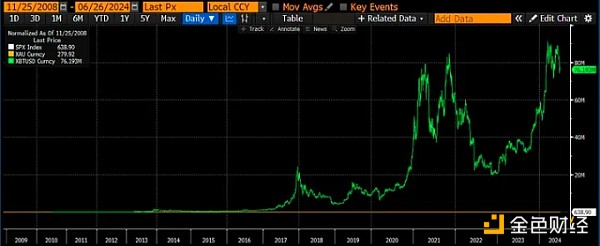
The S&P 500 (white), gold (gold), and Bitcoin (green) all have indices of 100 from November 25, 2008 to present.
This time, as the Fed devalues the dollar, capital is free to leave the system. The problem is that at the beginning of the current cycle, Bitcoin provided an alternative stateless currency. The key difference between Bitcoin and gold is that, in the words of Lynn Alden, Bitcoin's ledger is maintained by a cryptographic blockchain and the currency moves at the speed of light. In contrast, gold's ledger is maintained by nature and moves only as fast as humans can physically transfer gold. Compared to digital fiat currencies, Bitcoin is superior, while gold is inferior. Digital fiat currencies also move at the speed of light, but governments can print unlimited amounts. This is why Bitcoin has stolen some of gold's limelight from 2009 to now.
Bitcoin has performed so well that you can’t discern the difference in returns between gold and stocks on this chart. As a result, gold has underperformed stocks by nearly 300%.
The end of quantitative easing
While I think my contextualization and description of the last 100 years of financial history is incredible, it does little to allay concerns that the current bull market is over. We know we are in a period of inflation, and Bitcoin has done what it is supposed to do: outperform stocks and depreciate fiat currencies. However, timing is everything. If you bought Bitcoin at its recent all-time high, you might feel like a beta cheater because you extrapolated past results into an uncertain future. That being said, if we believe that inflation will continue and that war, whether cold, hot, or proxy, is imminent, what does the past tell us about the future?
Governments have consistently suppressed domestic savers to finance wars and past cycle winners and to maintain systemic stability. In this modern era of nation states and large integrated commercial banking systems, the primary way governments fund themselves and key industries is by deciding how banks allocate credit.
The problem with quantitative easing is that the market invests free money and credit in businesses that cannot produce the real products needed in a wartime economy. The American Revolution is the best example of this phenomenon. Volcker ushered in the era of the all-powerful central banker. Central bankers create bank reserves by buying bonds, thereby reducing costs and increasing the amount of credit.
In private capital markets, credit is allocated to maximize shareholder returns. The simplest way to increase stock prices is to reduce outstanding shares through buybacks. Companies with access to cheap credit borrow to buy back stock. They don’t borrow to add capacity or improve technology. Improving a business to generate more revenue is challenging and does not guarantee a higher stock price. But mathematically, by reducing outstanding shares, you can increase stock prices, and large-cap companies with cheap and ample credit have done so since 2008.
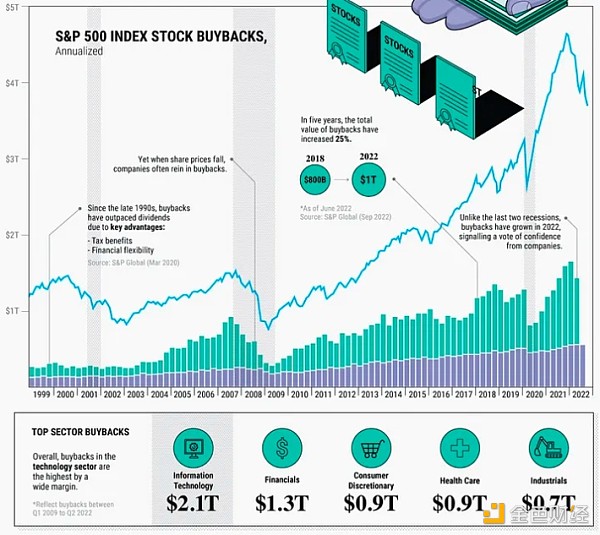
Another low-hanging fruit is higher profit margins. So instead of building new capacity or investing in better technology, share prices are used to lower labor input costs by moving jobs to China and other low-cost countries. U.S. manufacturing is in such a slump that it can’t produce enough ammunition to defeat Russia in Ukraine. Moreover, China is a much better place to make goods, and the U.S. Department of Defense supply chain is flooded with key inputs produced by Chinese companies.
Pax Americana and the way the West collectively allocates credit will be similar to how China, Japan, and South Korea do. Either the state directly instructs banks to lend to this or that industry/company, or banks are forced to buy government bonds at below-market yields so that the state can hand out subsidies and tax credits to the "right" businesses. In either case, the return on capital or savings will be below nominal growth and/or inflation. Assuming no capital controls are established, the only way out is to buy a store of value outside the system, such as Bitcoin.
For those who obsessively watch the changes in the balance sheets of major central banks and conclude that credit growth is not fast enough to drive cryptocurrency prices up again, you must now obsessively watch the amount of credit created by commercial banks. Banks do this by lending to non-financial businesses. Fiscal deficits also create credit because deficits must be financed by borrowing in the sovereign debt market, and banks will dutifully buy this debt.
Simply put, in the last cycle we monitored the size of the central bank's balance sheet, and in this cycle we will monitor the fiscal deficit and the total amount of non-financial bank credit.
Trading straregy
Why am I confident that Bitcoin will regain its momentum?
Why am I confident that we are in a new hyper-local, nation-state-first inflation cycle?
Take a good look at this little knowledge:
The U.S. budget deficit is expected to soar to $1.915 trillion in fiscal 2024, exceeding last year's $1.695 trillion to hit the highest level outside the COVID-19 era, a federal agency said, attributing a 27% increase from its earlier forecast to increased spending.
That's aimed at those who worry Biden won't step up spending to keep the economy running smoothly before the election.
The Atlanta Federal Reserve Bank predicts that real GDP growth in the third quarter of 2024 will reach an astonishing +2.7%.
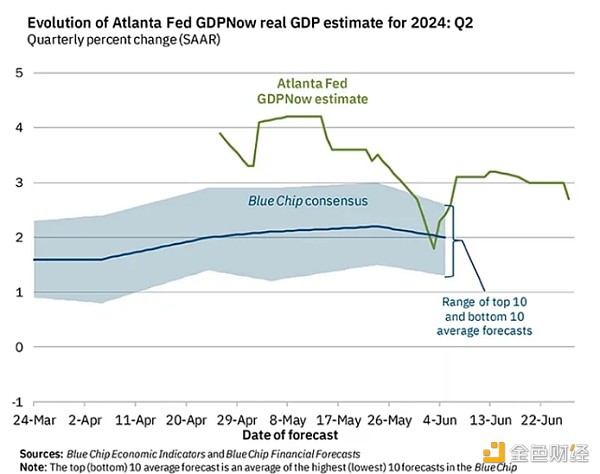
For those worried about a recession in Pax Americana, it is mathematically extremely difficult to experience a recession when government spending exceeds tax revenue by $2 trillion. That’s 7.3% of GDP in 2023. For context, US GDP growth fell by 0.1% in 2008 and by 2.5% during the 2009 global financial crisis. If a global financial crisis of similar severity were to occur again this year, private economic growth would still not fall by more than the amount of government spending. There would be no recession. That doesn’t mean a large swath of civilians wouldn’t be in serious financial trouble, but Pax Americana would continue regardless.
I point this out because I believe fiscal and monetary conditions are easy and will continue to be easy, and therefore, holding cryptocurrencies is the best way to preserve value. I believe today will be similar to the 1930s through 1970s, which means that given that I can still freely move from fiat to crypto, I should do so because devaluation through the expansion of the banking system and centralized credit allocation is imminent.






